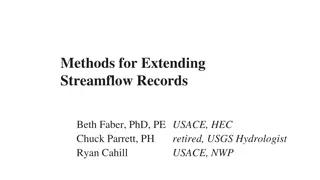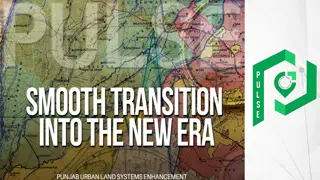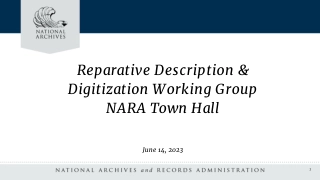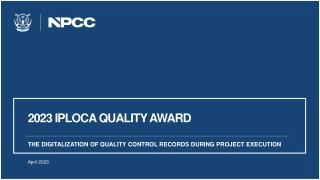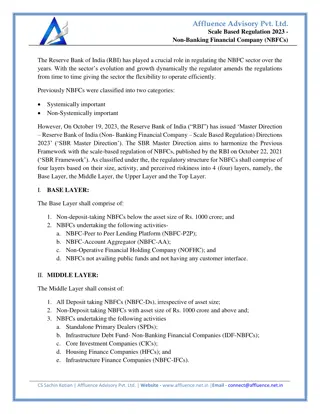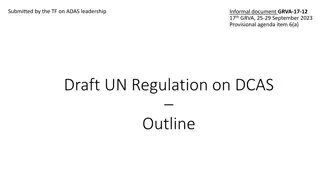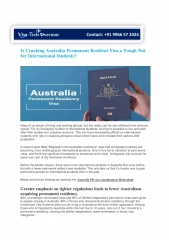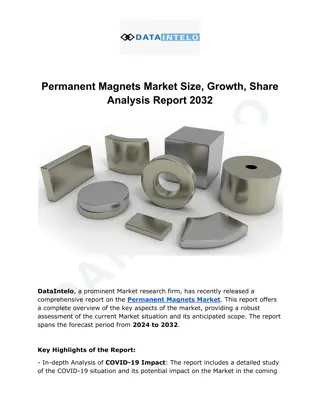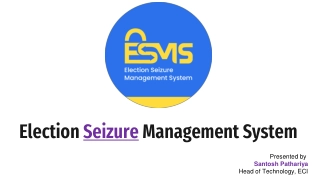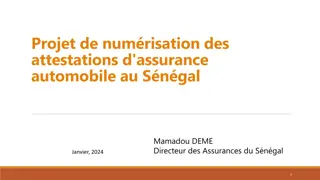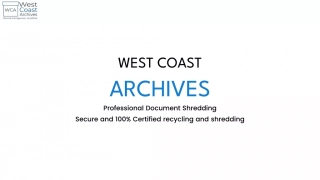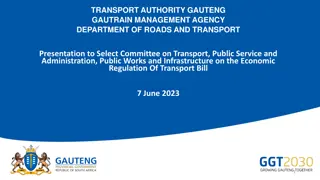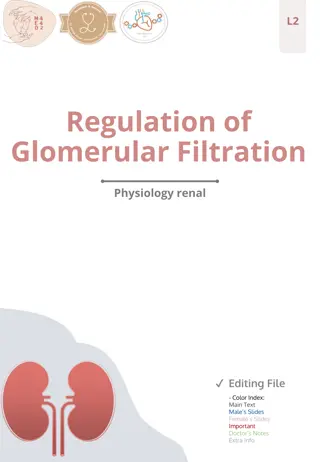NARA’s Regulation for Digitizing Permanent Records
NARA has issued regulations and guidance for digitizing permanent records, including the disposal of original analog records, with the aim of enhancing efficiency and accessibility. The process includes reviewing and updating regulations periodically, transferring metadata when records are transferred to the National Archives, and establishing standards for digitizing both temporary and permanent records. The final rule outlines requirements for digitization, validation, and disposal of original records, emphasizing the need for accuracy and compliance with NARA standards.
NARA’s Regulation for Digitizing Permanent Records
PowerPoint presentation about 'NARA’s Regulation for Digitizing Permanent Records'. This presentation describes the topic on NARA has issued regulations and guidance for digitizing permanent records, including the disposal of original analog records, with the aim of enhancing efficiency and accessibility. The process includes reviewing and updating regulations periodically, transferring metadata when records are transferred to the National Archives, and establishing standards for digitizing both temporary and permanent records. The final rule outlines requirements for digitization, validation, and disposal of original records, emphasizing the need for accuracy and compliance with NARA standards.. Download this presentation absolutely free.
Presentation Transcript
NARAs Regulation for Digitizing Permanent Records Wednesday, June 7, 2023 Agency Webinar 1
Welcome and Introductions! Lisa Haralampus, Director, Records Management Policy and Outreach John Martinez, Supervisor, Policy and Standards Kevin De Vorsey, Senior Electronic Records Policy Analyst 2
Guidance Impacting Approach Nov 2014: Federal Records Act Amendments Feb 2018: NARA Strategic Plan (updated 2022) Jun 2019: OMB/NARA Memo M-19-21 Dec 2022: OMB/NARA Memo M-23-07 The Archivist shall promulgate regulations establishing . . . standards for the reproduction of records by photographic, microphotographic, or digital processes with a view to the disposal of the original records. - FRA NARA will issue updated regulations and clear policies that permit agencies to digitize records created in analog formats and, where appropriate, dispose of analog originals. - M-23-07 3
Review Process Apr 2019: Digitization regulation for temporary records published as a final rule May 2020: Draft digitization regulation for permanent records sent for review to agencies Dec 2020: Draft digitization regulation for permanent records published for public comment Sep 2022: Draft digitization regulation for permanent sent for review to select agencies Feb 2023: Draft digitization regulation for permanent sent for review to select agencies review to select agencies May 4, 2023: Published as a final rule June 5, 2023: Digitization regulation goes into effect 4
Other items in Final Rule 36 CFR Subpart F -- Transfer Metadata When agencies transfer permanent records to the National Archives legal and physical custody, the agency must provide transfer metadata to NARA. The transfer metadata must be entered into the Electronic Records Archives (ERA) when the Transfer Request (TR) is created to begin transferring the records. Each transfer of digital records must include the following metadata that applies to the transfer as a whole. 36 CFR 1225.22(a) Every five years, agencies must review all records schedules that are ten years old and older, based on the date that NARA approved the schedule. Agencies may also review their agency records schedules on a more frequent regular basis to determine if they remain accurate. 5
Digitization Standards for Temporary Records 36 CFR Subpart D -- Digitizing Temporary Federal Records 1236.30 Requirements for digitizing temporary records. 1236.32 Digitization standards. 1236.34 Validating digitization. 1236.36 Disposing of original source records. 6
Digitization Standards for Permanent Records 36 CFR Subpart E -- Digitizing Permanent Federal Records 1236.40 Scope of this subpart 1236.50 Digitization requirements for permanent paper and photographic prints 1236.41 Definitions for this subpart 1236.52 Digitization requirements for permanent mixed-media files 1236.42 Records management requirements 1236.44 Documenting digitization projects 1236.54 Metadata requirements 1236.46 Quality management requirements 1236.56 Validating digitized records and disposition authorities 1236.48 File format requirements 7
36 CFR 1236.40 Scope Scope of this Subpart: This regulation applies to records that can be scanned using reflective techniques, such as: Paper records (all sizes and types) Printed photographs Mixed Media Records But not materials that are scanned using transmissive or other techniques, such as: Photographic negatives Motion picture film Microforms A/V records 8
36 CFR 1236.42 Records Management Records Management Requirements: Establish intellectual control. Records must be prepared, indexed, maintained in their original order. Survey source records for preservation problems and select equipment that safely digitizes originals. Identify the age, media types, dimensions, required level of detail, and condition of source records prior to digitization. 9
36 CFR 1236.44 Documentation Documentation Requirements: You must implement a program that digitizes records to the parameters in the regulation You must create the following documents when digitizing permanent records and retain them in association with the digitized records: A defined project plan Quality management plans describing quality assurance (QA) objectives that achieve the requirements Quality control (QC) procedures Documentation is retained by agencies, not transferred to NARA 10
36 CFR 1236.46 Quality Management Quality Management Requirements: Monitor and quantify scanner performance Identify and correct errors due to: Malfunctioning or improperly configured digitization equipment Improper software application settings Incorrect metadata capture Human error Regularly execute QC inspections of files for compliance with all parameters. 11
Federal Agencies Digital Guidelines Initiative (FADGI) Federal Agencies Digital Guidelines Initiative (FADGI) Digital Image Conformance Evaluation (DICE) 12
36 CFR 1236.48 File Formats File Format Requirements: Image data must be uncompressed or use one of the following visually lossless compression methods: Digital files for Textual and photographic print records must be encoded in the following formats: Uncompressed TIFF Deflate (Zip) JPEG 2000 JPEG 2000 part 1 core coding system lossless compression. (Agencies may use up to 20:1 visually lossless compression) PNG PDF/A (any version as long as the attachments feature is not used) 13
36 CFR 1236.50 Digitization Requirements Digitization Requirements for Permanent Paper and Photographic Print Records: The regulation has two major imaging specifications: Permanent paper and Prints and Photographs Equipment must be appropriate for media type, capable of meeting project requirements, and the imaging parameters Implement quality analysis using reference targets to verify conformance to imaging parameters Regularly test equipment to ensure they are operating optimally, at beginning of workday, start of each batch, or when problems are detected 14
36 CFR 1236.52 Mixed Media Digitization Requirements for Permanent Mixed-Media Files: Identify the contents of any electronic or analog storage media Determine whether any files on the storage media are records If the files are records, determine whether they are components of mixed-media files that are being digitized. If they are permanent records not associated with the rest of the records in the file migrate them to an electronic information system 15
36 CFR 1236.54 Metadata Metadata Requirements: Capture administrative metadata, including the source record s disposition and item number Capture descriptive metadata from source records at the record level Capture descriptive rights and restrictions metadata from source records at the record level, to document any that relate to the records Generate and capture technical metadata Generate checksums when digitization is complete Capture technical metadata describing the digitization process and resulting electronic records 16
36 CFR 1236.56 Validation Validating Digitized Records and Disposition Authorities Ensure that digitized records meet all image quality, metadata, and records management requirements A separate step from quality management Ensure that the digitized records are complete and accurate, and can meet the same business needs as the originals Agencies should consult with their General Counsel to ensure that their validation process is sufficient 17
https://www.archives.gov/records-mgmt/policy/digitization 18
Additional Products We are issuing a series of blog posts on Records Express with more discussion about digitization. We are issuing a new GRS 4.5 and revising existing GRS 5.2 We are continuing to develop additional guidance products and resources over the next several months. We are also working on digitization standards for film records. The current plans are to incorporate these standards into the existing regulation. 19
Questions? Seventh and eighth grade class in Westley, CA school after lesson in geography. National Archives Identifier: 148741583. 20


